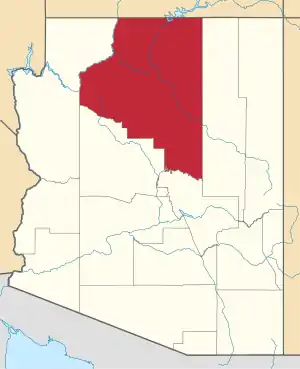Tuba City, Arizona
Tó Naneesdizí | |
|---|---|
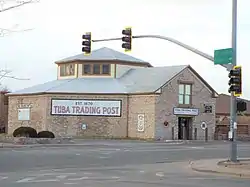 Tuba Trading Post built in 1905 | |
 Location in Coconino County and the state of Arizona | |
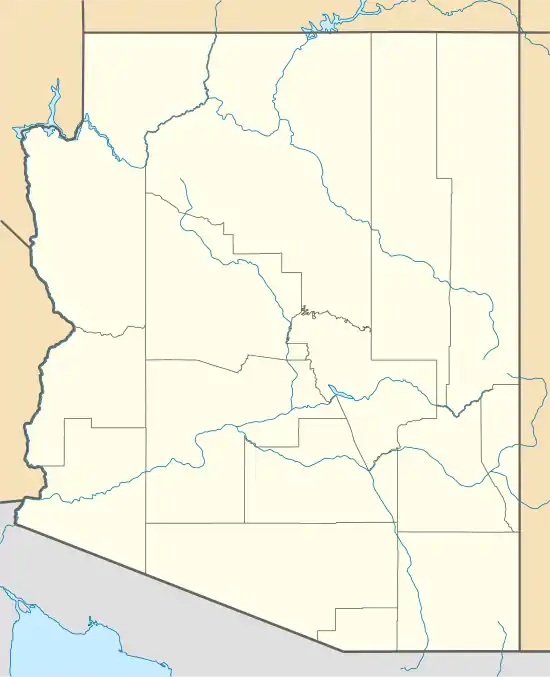 Tuba City Location in Arizona#Location in the United States  Tuba City Tuba City (the United States) | |
| Coordinates: 36°07′30″N 111°14′50″W / 36.12500°N 111.24722°W | |
| Country | |
| State | |
| County | Coconino |
| Government | |
| • Type | Navajo chapter |
| • Chapter president | Gerald Keetso |
| Area | |
| • Total | 8.97 sq mi (23.24 km2) |
| • Land | 8.97 sq mi (23.24 km2) |
| • Water | 0.00 sq mi (0.00 km2) |
| Elevation | 4,918 ft (1,499 m) |
| Population (2020) | |
| • Total | 8,072 |
| • Estimate (2016)[3] | N/A |
| Time zone | UTC-7 (MST) |
| • Summer (DST) | UTC-6 (MDT) |
| ZIP code | 86045 |
| Area code | 928 |
| FIPS code | 04-76010 |
| GNIS feature ID | 2409355[2] |
Tuba City (Navajo: Tó Naneesdizí) is an unincorporated town in Coconino County, Arizona, on the Navajo Nation, United States. It is the second-largest community in Coconino County. The population of the census-designated place (CDP) was 8,611 at the 2010 census.[4]
It is the most populous community within the Navajo Nation, slightly larger than Shiprock, New Mexico, and the site of the headquarters of the Western Navajo Agency. The Hopi village of Moenkopi lies directly to its southeast, and Hopi also live in the city.
European Americans named the town in honor of chief Tuuvi, a Hopi man from Oraibi who converted to the Church of Jesus Christ of Latter-day Saints and allowed Mormon migrants to settle in the area. The Navajo name for this community, Tó Naneesdizí, translates as "tangled waters". It likely refers to the many below-ground springs that are the source of several reservoirs.
Tuba City is located within the Painted Desert near the western edge of the Navajo Nation. Tuba City is located approximately 50 miles (80 km) from the eastern entrance to Grand Canyon National Park and approximately 78 miles (126 km) from Flagstaff. Most of Tuba City's residents are Navajo, with a small Hopi minority.
History

The Tuba City area was the territory of indigenous peoples for thousands of years. The community was first documented by Spanish explorers: Father Francisco Garcés visited the area in 1776, and recorded that the Hopi Indians were cultivating crops.[5]
European-American migrants came as part of the Mormon movement to the West in the late 19th century. They named the town after Tuuvi, a Hopi man who converted to Mormonism circa 1870. He had invited the Mormons to settle near his village of Moenkopi without requiring them to gain individual permission. The Tuba City Trading Post was established in 1870, dealing with the Navajo and Paiute who came to the area for the natural springs, as well as the Hopi already in the area. European-American Mormon emigrants claimed to found Tuba City in 1872.
In 1956, uranium began to be mined near Tuba City. The regional office for the Rare Metals Corporation was established here, which founded a mill for processing.[6] The Atomic Energy Commission had an office here as well.[7] The mill closed in 1966. Reclamation of the millsite and tailings pile was completed in 1990 because the tailings had high radioactive content and were environmentally hazardous waste products that had to be cleared.[8]
The Tuba City Regional Health Care Corporation hospital is located in Tuba City. It is a non-profit, Native American-run health care corporation that employs 1,200 people. The next nearest hospital is in Flagstaff.[9]
Geography and climate
According to the United States Census Bureau, the CDP has a total area of 8.9 square miles (23 km2), all land.[10]
Geologically, Tuba City is sited about the Glen Canyon Group from the early Jurassic (about 180–210 Ma) and on modern superficial Quaternary deposits.[11]
It is located within the Painted Desert near the western edge of the Navajo Nation. The town is served by U.S. Route 160, near the junction with Arizona State Route 264. Tuba City is located approximately 50 miles (80 km) from the eastern entrance to Grand Canyon National Park and approximately 78 miles (126 km) from Flagstaff.
Arizona does not observe Daylight Saving Time, but the Navajo Nation does within its boundaries. In practice elements of Tuba City vary in practices: tribal offices and schools observe DST, while most private businesses conform to state practice and do not.
Tuba City is located in the rain shadow of the Mogollon Rim, which keeps out moisture from the Gulf of California. It has a cold desert climate (Köppen BWk) with hot, dry summers – though less hot than Phoenix – and cold, dry winters. Frosts are normal from October to April. The majority of winters do not have measurable snowfall due to the dryness of the air descending from mountains to the south.
| Climate data for Tuba City, Arizona (1991–2020 normals, extremes 1897–2013) | |||||||||||||
|---|---|---|---|---|---|---|---|---|---|---|---|---|---|
| Month | Jan | Feb | Mar | Apr | May | Jun | Jul | Aug | Sep | Oct | Nov | Dec | Year |
| Record high °F (°C) | 67 (19) |
76 (24) |
84 (29) |
94 (34) |
100 (38) |
110 (43) |
110 (43) |
108 (42) |
103 (39) |
95 (35) |
81 (27) |
71 (22) |
110 (43) |
| Mean maximum °F (°C) | 58.4 (14.7) |
64.5 (18.1) |
75.0 (23.9) |
83.5 (28.6) |
91.9 (33.3) |
98.9 (37.2) |
102.1 (38.9) |
99.3 (37.4) |
94.1 (34.5) |
85.2 (29.6) |
69.7 (20.9) |
58.0 (14.4) |
102.7 (39.3) |
| Mean daily maximum °F (°C) | 47.0 (8.3) |
54.0 (12.2) |
62.6 (17.0) |
70.7 (21.5) |
80.1 (26.7) |
91.3 (32.9) |
94.8 (34.9) |
92.3 (33.5) |
84.9 (29.4) |
72.9 (22.7) |
58.4 (14.7) |
46.3 (7.9) |
71.3 (21.8) |
| Daily mean °F (°C) | 35.4 (1.9) |
40.6 (4.8) |
48.3 (9.1) |
55.0 (12.8) |
64.3 (17.9) |
74.0 (23.3) |
79.2 (26.2) |
77.3 (25.2) |
69.4 (20.8) |
57.5 (14.2) |
44.8 (7.1) |
34.6 (1.4) |
56.7 (13.7) |
| Mean daily minimum °F (°C) | 23.9 (−4.5) |
27.2 (−2.7) |
34.0 (1.1) |
39.2 (4.0) |
48.6 (9.2) |
56.6 (13.7) |
63.6 (17.6) |
62.3 (16.8) |
54.0 (12.2) |
42.1 (5.6) |
31.1 (−0.5) |
22.8 (−5.1) |
42.1 (5.6) |
| Mean minimum °F (°C) | 13.4 (−10.3) |
17.9 (−7.8) |
23.8 (−4.6) |
28.6 (−1.9) |
34.6 (1.4) |
43.7 (6.5) |
56.0 (13.3) |
54.0 (12.2) |
42.9 (6.1) |
29.0 (−1.7) |
18.4 (−7.6) |
11.1 (−11.6) |
9.5 (−12.5) |
| Record low °F (°C) | −15 (−26) |
−8 (−22) |
5 (−15) |
14 (−10) |
12 (−11) |
29 (−2) |
37 (3) |
33 (1) |
20 (−7) |
11 (−12) |
−4 (−20) |
−13 (−25) |
−15 (−26) |
| Average precipitation inches (mm) | 0.46 (12) |
0.42 (11) |
0.53 (13) |
0.21 (5.3) |
0.49 (12) |
0.09 (2.3) |
0.72 (18) |
0.79 (20) |
1.18 (30) |
0.64 (16) |
0.43 (11) |
0.31 (7.9) |
6.27 (159) |
| Average snowfall inches (cm) | 0.4 (1.0) |
0.7 (1.8) |
0.1 (0.25) |
0.0 (0.0) |
0.0 (0.0) |
0.0 (0.0) |
0.0 (0.0) |
0.0 (0.0) |
0.0 (0.0) |
0.0 (0.0) |
0.0 (0.0) |
0.7 (1.8) |
1.9 (4.85) |
| Average precipitation days (≥ 0.01 inch) | 3.5 | 3.9 | 3.9 | 1.9 | 2.4 | 1.0 | 3.9 | 5.4 | 4.5 | 3.4 | 2.2 | 2.9 | 38.9 |
| Average snowy days (≥ 0.1 inch) | 0.4 | 0.4 | 0.1 | 0.0 | 0.0 | 0.0 | 0.0 | 0.0 | 0.0 | 0.0 | 0.0 | 0.6 | 1.5 |
| Source: NOAA(snowfall and snowy days 1981–2010)[12][13] | |||||||||||||
Demographics
| Census | Pop. | Note | %± |
|---|---|---|---|
| 1990 | 7,323 | — | |
| 2000 | 8,225 | 12.3% | |
| 2010 | 8,611 | 4.7% | |
| 2020 | 8,662 | 0.6% | |
| U.S. Decennial Census[14][15] | |||
| Languages (2000) [16] | Percent |
|---|---|
| Spoke Navajo at home | 61.2% |
| Spoke English at home | 37.5% |
| Spoke Hopi at home | 0.5% |
| Spoke Spanish at home | 0.8% |
2020 census
As of the 2020 census there were 8,072 people, 2,550 housing units, and 2,428 families in the CDP. The population density was 899.5 inhabitants per square mile. The racial makeup of the CDP was 5.0% White (223 people), 1.2% African American (28), 91.8% Native American (7,488), 0.0% Asian (118), 0.2% Pacific Islander (6), and 0.7% from two or more races (176). Those of Hispanic or Latino origin made up 5.6% (147).[17][18]
The median age was 34.5 years old. 10.9% of the population were 65 or older, with 7.2% between the ages of 65 to 74, 3.2% between the ages of 75 to 84, and 0.6% were 85 or older. 1.5% of the population were foreign born. 26.7% of the population were under 18, and 6.6% were under 5. The gender makeup was 54.1% female and 45.9% male.[17][18]
The median household income was $57,045, with families having $58,750, married couples had $86,979, and non-families had $41,875. 23.1% of the population were in poverty. The per capita income was $20,287.[18][17]
2015 census
As of the census[19] of 2015, there were 9,722 people, 2,360 households, and 1,675 families residing in the CDP. The population density was 921.6 inhabitants per square mile (355.8/km2). There were 2,465 housing units at an average density of 274.0 per square mile (105.8/km2). The racial make-up of the CDP was 76.2% Native American, 8.4% White, 0.3% Black or African American, 0.8% Asian, <0.1% Pacific Islander, 0.6% from other races, and 1.5% from two or more races. 14.4% of the population were Hispanic or Latino of any race.
There were 2,360 households, out of which 52.9% had children under the age of 18 living with them, 49.0% were married couples living together, 26.0% had a female householder with no husband present, and 17.7% were non-families. 15.1% of all households were made up of individuals, and 2.3% had someone living alone who was 65 years of age or older. The average household size was 4.00 and the average family size was 4.49.
In the CDP, the age distribution of the population shows 42.8% under the age of 18, 9.8% from 18 to 24, 27.5% from 25 to 44, 15.7% from 45 to 64, and 4.3% who were 65 years of age or older. The median age was 23 years. For every 100 females, there were 93.8 males. For every 100 females age 18 and over, there were 87.3 males.
Tuba City's median household income is $47,091, and the median income for a family was $37,813. Males had a median income of $29,280 versus $26,855 for females. The per capita income for the CDP was $14,140. About 23.1% of families and 28.2% of the population were below the poverty line, including 33.0% of those under age 18 and 44.8% of those age 65 or over.
Attractions
The following attractions and infrastructure are located in Tuba City:
- The Explore Navajo Interactive Museum, opened in 2007, is located next to the historic Tuba City Trading Post.[20]
- Ancient dinosaur tracks have been found and are preserved about 5 miles (8 km) west of the town.
- Coal Mine Canyon, a colorful canyon with many hoodoos, is 15 miles (24 km) southeast.
- Hahonogeh Canyon, near Coal Mine Canyon, is noteworthy for blue colors most visible at sunrise and sunset.
- The Hopi have expanded tourist offerings: their Tuuvi Travel Center opened in 2008, a complex that cost $6.3 million. In 2010 they opened a motel, which cost $13 million. In 2011 a Denny's franchise restaurant opened across US Highway 160. The Hopi Nation plan a $100 million "Gateway to Hopiland" nearby.[7]
 Tuba City Chapter House of the Navajo Nation.
Tuba City Chapter House of the Navajo Nation.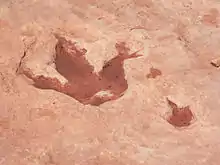 Dinosaur track in Tuba City
Dinosaur track in Tuba City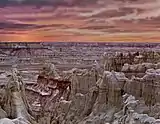 Coal Mine Canyon at sunset
Coal Mine Canyon at sunset Moonrise at Coal Mine Canyon
Moonrise at Coal Mine Canyon
Transportation
The town is served by U.S. Route 160, near the junction with Arizona State Route 264.
It is served by the Tuba City Airport.[21]
Navajo Transit System provides connections to Flagstaff and Fort Defiance.[22] Hopi Senom Transit provides connections to Moenkopi.[23] Express provides connecting service to Page.[24]
Education
The area is served by the Tuba City Unified School District, as well as several tribal/federal schools within the area.
Schools in Tuba City include:
- Tuba City High School
- Tuba City Jr. High School
- Eagles' Nest Intermediate School
- Tuba City Primary School
- Nizhoni Accelerated Academy
Bureau of Indian Education (BIE) schools include:
- Greyhills Academy High School (tribal)
- Tuba City Boarding School (Bureau-operated) established 1906
Moencopi Day School (tribal) is in nearby Moenkopi.[25]
Tertiary institutions include:
- Diné College Tuba City Center[26]
- Online classes from Northern Arizona University.
Sports
On January 4, 1988, Northern Arizona beat Central Connecticut 72–70 in Tuba City in the first Division I basketball game ever played on an Indian reservation.
Notable people
- Mary Morez, artist, was born near Tuba City[27]
- Jonathan Nez, ninth and current President of the Navajo Nation
- Lori Piestewa, a soldier in the US Army, was killed in southern Iraq in 2003. In honor of her, Squaw Peak in Phoenix was renamed Piestewa Peak in 2008
- Sunshine Sykes, a federal judge on the Central District of California
- Aaron Yazzie, a mechanical engineer at NASA's Jet Propulsion Laboratory, was born in Tuba City
References
- ↑ "2016 U.S. Gazetteer Files". United States Census Bureau. Retrieved July 18, 2017.
- 1 2 U.S. Geological Survey Geographic Names Information System: Tuba City, Arizona
- ↑ "Population and Housing Unit Estimates". Census.gov. Retrieved June 9, 2017.
- ↑ "Profile of General Population and Housing Characteristics: 2010 Demographic Profile Data (DP-1): Tuba City CDP, Arizona". United States Census Bureau. Retrieved December 8, 2011.
- ↑ "Arizona Relocation Guide". Arizonan.com. Archived from the original on November 4, 2013. Retrieved October 12, 2017.
- ↑ "Tuba City Mill". Eia.doe.gov. Retrieved October 12, 2017.
- 1 2 Amy Maestas, "Tuba City, Arizona" Archived 2008-08-28 at the Wayback Machine, Inside Outside Southwest Archived 2013-01-27 at archive.today, July 2008,
- ↑ "The Center for Land Use Interpretation". Clui.org. Retrieved October 12, 2017.
- ↑ "About Us". Tuba City Health. Retrieved November 26, 2020.
- ↑ "US Gazetteer files: 2010, 2000, and 1990". United States Census Bureau. February 12, 2011. Retrieved April 23, 2011.
- ↑ "The Arizona Geological Survey – Geologic Map of Arizona (1:1,000,000 scale)". October 16, 2009. Archived from the original on October 16, 2009. Retrieved October 12, 2017.
{{cite web}}: CS1 maint: bot: original URL status unknown (link) - ↑ "NOWData – NOAA Online Weather Data". National Oceanic and Atmospheric Administration. Retrieved August 14, 2022.
- ↑ "U.S. Climate Normals Quick Access – Station: Tuba City, AZ". National Oceanic and Atmospheric Administration. Retrieved January 28, 2023.
- ↑ "Census of Population and Housing". Census.gov. Retrieved June 4, 2016.
- ↑ "Tuba City CDP". US Census Bureau. Retrieved November 26, 2020.
- ↑ "Data Center Results". apps.mla.org. Retrieved October 12, 2017.
- 1 2 3 "U.S. Census Bureau QuickFacts: Tuba City CDP, Arizona". www.census.gov. Retrieved June 5, 2023.
- 1 2 3 "Explore Census Data". data.census.gov. Retrieved June 5, 2023.
- ↑ "U.S. Census website". United States Census Bureau. Retrieved January 31, 2008.
- ↑ "Museum". Explore Navajo Attractions. Archived from the original on October 30, 2012.
- ↑ FAA Airport Form 5010 for T03 PDF. Federal Aviation Administration. Effective 25 August 2011.
- ↑ "Navajo Transit System > Route and Schedules". Archived from the original on January 20, 2021. Retrieved December 13, 2021.
- ↑ "Department of Public Works & Transportation".
- ↑ "Routes and Maps".
- ↑ "Directions". Moencopi Day School. Archived from the original on July 31, 2021. Retrieved July 30, 2021.
Moencopi Day School Inc 322 AZ-264, Tuba City, AZ 86045
– Compare with the US Census Bureau Map of Moenkopi - ↑ "Tuba City". Diné College. Retrieved July 30, 2021.
600 Edgewater Dr. [...] Tuba City, AZ 85045
- ↑ "Mary Morez – Artist, Fine Art Prices, Auction Records for Mary Morez". Askart.com. Retrieved January 28, 2017.
